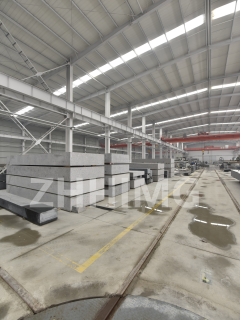In the field of precision manufacturing, granite as a high-quality natural stone, because of its unique physical and chemical properties, is widely used in precision instruments, equipment and measuring tools. However, despite its many advantages, the processing difficulty of granite precision components cannot be ignored.
First, the hardness of granite is extremely high, which brings great challenges to its processing. High hardness means that in the machining process such as cutting and grinding, the wear of the tool will be very fast, which not only increases the processing cost, but also reduces the processing efficiency. In order to cope with this problem, the processing process needs to use high-quality diamond tools or other cemented carbide tools, while strictly controlling the cutting parameters, such as cutting speed, feed rate and cutting depth, to ensure the durability of the tool and processing accuracy.
Secondly, the structure of granite is complex, there are micro-cracks and discontinuities, which increase the uncertainty in the processing process. During the cutting process, the tool may be guided by these micro-cracks and cause deviation, resulting in machining errors. In addition, when the granite is subjected to cutting forces, it is easy to produce stress concentration and crack propagation, which affects the machining accuracy and mechanical properties of the components. In order to reduce this impact, the processing process needs to use appropriate coolant and cooling methods to reduce the cutting temperature, reduce thermal stress and crack generation.
Moreover, the machining accuracy of granite precision components is extremely high. In the fields of precision measurement and integrated circuit processing, the geometric accuracy of components such as flatness, parallelism and verticality is very strict. In order to meet these requirements, the processing process needs to use high-precision processing equipment and measuring tools, such as CNC milling machines, grinding machines, coordinate measuring machines and so on. At the same time, it is also necessary to strictly control and manage the machining process, including the clamping method of the workpiece, the selection of the tool and the monitoring of wear, the adjustment of the cutting parameters, etc., to ensure the machining accuracy and stability.
In addition, the processing of granite precision components also faces some other difficulties. For example, due to the poor thermal conductivity of granite, it is easy to produce local high temperature during processing, resulting in workpiece deformation and surface quality decline. To solve this problem, proper cooling methods and cutting parameters need to be used in the machining process to reduce the cutting temperature and reduce the heat affected zone. In addition, the processing of granite will also produce a large amount of dust and waste, which need to be properly disposed of to avoid harm to the environment and human health.
In summary, the processing difficulty of granite precision components is relatively high, and it is necessary to use high-quality tools, high-precision processing equipment and measuring tools, and strictly control the processing process and parameters. At the same time, it is also necessary to pay attention to the cooling, dust removal and other issues in the processing process to ensure the processing accuracy and the quality of the components. With the continuous progress of science and technology and the continuous development of processing technology, it is believed that the processing difficulty of granite precision components will be gradually reduced in the future, and its application in the field of precision manufacturing will be more extensive.
Post time: Jul-31-2024

